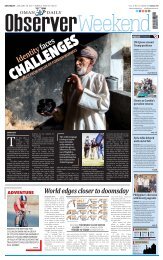GROWING
ICLt100AJRg
ICLt100AJRg
Create successful ePaper yourself
Turn your PDF publications into a flip-book with our unique Google optimized e-Paper software.
LEISURE<br />
5<br />
SATURDAY l FEBRUARY 18 l 2017<br />
OMANDAILYOBSERVER<br />
JOSEPH NASR<br />
BERLINOne drops you, trapped and<br />
powerless, in the middle of<br />
a civil war, while the other<br />
uses humour to depict<br />
what’s it like to start a<br />
new life in Europe after escaping the same<br />
conflict.<br />
“Insyriated” and “The Other Side of<br />
Hope” are two films about Syria, and they<br />
brought tears and smiles to the Berlin Film<br />
Festival.<br />
Set entirely in a few rooms over the<br />
course of one day as skirmishes rage and<br />
ebb around them, Insyriated is designed<br />
as an intense ensemble piece in which the<br />
mother’s single-minded determination to<br />
ensure the safety of her charges is severely<br />
tested by outside forces.<br />
Philippe Van Leeuw’s direction is<br />
more fluid than his dialogue, and there’s<br />
a crudeness to certain scenes that takes<br />
the viewer out of the horror exactly when<br />
we’re meant to feel it most. The sense of<br />
suffocation remains, however, and given the<br />
subject’s topicality, “Insyriated” will likely<br />
see scattered play, especially at human-rights<br />
showcases.<br />
A concisely-told story that couldn’t be<br />
more timely in view of the traumas currently<br />
afflicting the Syrian people, Insyriated<br />
features a terrific lead performance by<br />
Hiam Abbass heading a multi-generational<br />
ensemble cast.<br />
Playing the lady of the house, Hiam<br />
Abbass delivers an edge-of-seat performance,<br />
supported by a career-changing turn by<br />
Lebanese actress Diamand Bou Abboud as<br />
a young mother who undergoes a horrible<br />
ordeal.<br />
By focusing on these two women, the<br />
SYRIAN<br />
FILMS<br />
bring<br />
tears and<br />
smiles<br />
film underlines the courage under fire of<br />
ordinary Syrians who find themselves caught<br />
in the midst of an all-out war while they sit<br />
in their living room. It’s harrowing just to<br />
watch this film, and the audience at its Berlin<br />
Panorama premiere trooped out mutely after<br />
the screening, too stunned to talk.<br />
“It shocked people in a very smart<br />
way. Westerners saw enough images of<br />
destruction on their television screens. But<br />
few of them know what Syrians are going<br />
through or how they feel being trapped in<br />
there,” Iraqi film critic Kais Kasim said.<br />
The film forces viewers to ask themselves<br />
how they would act in the same situation.<br />
Belgian director Philippe Van Leeuw said<br />
the silence that followed the screening as well<br />
as seeing some of his actors and members of<br />
the audience in tears at the end made him<br />
think: “Mission accomplished.”<br />
“It is hard for me to say I was happy when<br />
I saw the film for the first time with the<br />
audience,” said actress Hiam Abbass, who<br />
plays Oum Yazan.<br />
“It brought people close to the Syrian<br />
people,” she said, adding that she had no<br />
idea the film would leave people speechless.<br />
“The Other Side of Hope” by Finnish<br />
director Aki Kaurismaki uses humour<br />
to depicts the experiences in Helsinki of<br />
stowaway Syrian asylum seeker Khaled, who<br />
decides to remain in the country illegally<br />
after his application is rejected.<br />
“The Other Side of Hope,” the new<br />
Kaurismäki film that just premiered at the<br />
Berlin International Film Festival, is set in<br />
Helsinki, a cosmopolitan city that, in this<br />
movie, at least, looks like a quaint, dinky,<br />
pre-tech-era throwback. People sit in offices<br />
in front of tiny manual typewriters, or they<br />
stub out cigarettes in kitchens that look like<br />
they belong in a Diane Arbus photograph.<br />
A restaurant bar serves sardines — right<br />
out of the can! — and has a décor that<br />
consists of nothing more than bare walls, a<br />
few tables and chairs, and a painting of Jimi<br />
Hendrix. Is this what a dive in Helsinki really<br />
looks like? Or is it just another of Kaurismäki’s<br />
bare-bones movie sets? Maybe a bit of both.<br />
His fate is to meet the main character in the<br />
second story of the film, Finnish salesman<br />
Wikstrom, who buys a restaurant in the capital<br />
where he gives Khaled a job and a bed.<br />
Wikstrom and the other Finns in the film<br />
are burlesque characters, the source of most<br />
of the light-hearted humour that almost<br />
obscures Khaled’s ordeal: most of his family<br />
died in a bomb in Aleppo and he lost his<br />
sister shortly after they arrived in Europe<br />
from Turkey.<br />
A soothing balm for<br />
genre<br />
Debbie Harry,<br />
frontwoman of rock<br />
band Blondie, was<br />
crowned a fashion<br />
icon at London’s Elle<br />
Style Awards, and she thanked her<br />
punk influences for defining her style.<br />
“Coming from the punk<br />
point of view, which was very<br />
deconstructionist, destructive,<br />
and disrespectful, you have to find<br />
something in yourself that makes<br />
you feel a lot of different ways,” she<br />
said at the red carpet event late on<br />
Monday.<br />
“So you have to feel beautiful, you<br />
have to feel comfortable. I have to feel<br />
sexy.”<br />
Harry, who attended the event<br />
with Blondie co-founder Chris Stein,<br />
playfully wore a crown designed by<br />
Vivienne Westwood, while posing<br />
for photographers. Harry also wore a<br />
Westwood red suit with a black-andwhite<br />
shirt and shoes.<br />
Blondie, an American punk band<br />
famous for hits like “Heart of Glass”<br />
and “Call Me” in the late 1970s and<br />
early 1980s, is expected to release<br />
their 11th studio album, “Pollinator”,<br />
in May.<br />
Debbie Harry was born Deborah<br />
Ann Harry on July 1, 1945, in Miami,<br />
Harry is the<br />
Style Icon<br />
Florida, and was adopted by Richard<br />
and Catherine Harry when she<br />
was 3 months old. Growing up in<br />
Hawthorne, New Jersey, Harry sang<br />
in the church choir.<br />
She tried college for two years<br />
before dropping out and moving to<br />
New York City. Having sang with the<br />
1960s’ band Wind in the Willows and<br />
worked as a Playboy Bunny, Harry<br />
ended up waiting tables at Max’s<br />
Kansas City, a popular club that was<br />
part of the downtown art and music<br />
scene.<br />
“It’s about the ongoing circle<br />
of culture and how we all feed off<br />
of each other and I think at this<br />
particular time... it’s very important<br />
to remember that. That we’re all so<br />
deeply connected,” Harry said about<br />
the new album.<br />
British actress and United Nations<br />
Women Global Goodwill Ambassador<br />
Emma Watson was given the Woman<br />
of the Year award in recognition of<br />
her acting career and work for gender<br />
equality.<br />
Other winners included French<br />
singer-songwriter Christine and the<br />
Queens, who won Album of the Year,<br />
and Christopher Bailey took home<br />
British Brand of the Year for Burberry.<br />
Erdem Moralioglu won British<br />
Designer of the Year.<br />
Blondie’s self-titled debut was<br />
released in 1976. The following year,<br />
the band toured in support of their<br />
second album, Plastic Letters, which<br />
scored a No 2 spot on the British<br />
charts with single “Denis.” Over the<br />
years, Blondie would continue to be a<br />
formidable force in the UK.<br />
SAKET SUMAN<br />
Pulitzer Prize-winning<br />
author Jhumpa<br />
Lahiri’s latest book, at<br />
first glance, is a sort<br />
of soothing balm that<br />
brings much-needed relief in the<br />
non-fiction genre — addressing a<br />
significant aspect of the publishing<br />
industry, ignored for far too long<br />
— which instantly catches the<br />
imagination of readers.<br />
But, does the offering answer as<br />
many questions as it raises remains to<br />
be decided.<br />
The axiom that advises readers<br />
not to judge a book by its cover finds<br />
a challenge in Lahiri’s examination of<br />
book covers. And why not, if you look<br />
at the extent to which book covers have<br />
been decisive in the success, as also<br />
the failure, of books in contemporary<br />
times.<br />
In short, the attention span of a<br />
normal reader is shrinking while the<br />
number of books on offer is multiplying<br />
manifold. Thus, the jacket plays a much<br />
more vital role today than it would have<br />
in the past.<br />
The author’s clarity is commendable,<br />
her choice of diction and simple flow of<br />
words are sufficient to keep the readers<br />
involved for the duration of a 71-pagelong<br />
quick read. But the offering, which<br />
is more of a lengthy essay, demands<br />
sincere and uninterrupted attention<br />
to understand the subtle yet complex<br />
issues around book covers that Lahiri<br />
explores. Interestingly, the book<br />
begins on a rather unusual note,<br />
“The Charm of the Uniform”. Lahiri<br />
recalls being fascinated by the school<br />
uniform of her cousins in Calcutta<br />
(now Kolkata) and was herself<br />
“tormented” by the freedom to wear<br />
whatever one wanted in her school<br />
in the US and says she would have<br />
BOOK:<br />
The Clothing of Books<br />
AUTHOR:<br />
Jhumpa Lahiri<br />
PUBLISHER:<br />
Penguin<br />
preferred a uniform herself.<br />
But is the author hinting at some<br />
sort of uniformity in book covers? If<br />
so, what would be the ideal uniform<br />
for all books?<br />
Lahiri reminds readers that<br />
her mother “barely tolerated my<br />
American clothes. She did not find<br />
my jeans or T-shirts cute. The older I<br />
grew, the more it mattered to her that<br />
I, too, wear Indian or, at the very least,<br />
concealing clothing. She held out for<br />
my becoming a Bengali woman like<br />
her.”<br />
This is customary for many Indian<br />
families. It is the context of book covers<br />
that lends an altogether different<br />
dimension to Lahiri’s childhood<br />
protests against, both, freedom to wear<br />
what one wanted at school and her<br />
mother wanting her to wear concealing<br />
clothing.<br />
Was it regressive for a mother to<br />
demand that her child wears only the<br />
“traditional clothing of her country”<br />
or was Lahiri’s “American clothes”, a<br />
normal result of her upbringing in the<br />
Western world?<br />
In any case, if the same formula<br />
is applied to the theme that Lahiri<br />
explores, one again falls short of<br />
answers.<br />
Lahiri says that she would “certainly<br />
prefer the uniformed elegance of a<br />
series to an insipid cover” and calls<br />
for upholding aesthetic values of book<br />
covers. Lastly, a word on the cover of<br />
“The Clothing of Books”. A simple<br />
blue cover, displaying only the title<br />
and author’s name, it just falls short<br />
of appearing elegant. It looks simple,<br />
unadorned and even undecorated.<br />
While this may not be among the<br />
eye-catchers in a bookstore displaying<br />
hundreds of books, it is perhaps close<br />
to how the author expects her book<br />
covers to be.<br />
FROM P1<br />
Matchmaking a<br />
<strong>GROWING</strong><br />
business<br />
Of course, compatibility is not a fullproof<br />
science — there are couples who<br />
got along very well before marriage but<br />
got separated after tying the knot due to<br />
compatibility issues.”<br />
Online matchmaking sites are popular<br />
with Omani men and women who believe<br />
they are past the ‘most eligible’ threshold<br />
for marriage. Some desperate people also<br />
falsify their details in the hope of snagging<br />
a good match. Take the example of 34-yearold<br />
Muna, who had recently approached a<br />
matchmaker for assistance.<br />
“Having crossed my thirties, my<br />
chances of getting married were not too<br />
bright. In desperation, I decided to seek<br />
out a matchmaker. But in the information<br />
that I had disclosed, I did not furnish my<br />
exact age — a mistake that came back<br />
to haunt me. Not long thereafter, a man<br />
came to propose to me but found out I<br />
was older than I had claimed. I was truly<br />
embarrassed.”<br />
Muna is determined to get the help of a<br />
matchmaker in her quest for wedded bliss,<br />
but she urges prospective brides to furnish<br />
their correct details because, as she stresses,<br />
the “entire matchmaking process and the<br />
build-up to a relationship between two<br />
individuals requires truthfulness”.<br />
Muna cautions against matchmakers<br />
who charge exorbitant amounts of up to<br />
RO 1,000 per couple upon a successful<br />
match. “I think since she is doing this<br />
business for a good cause, she should<br />
keep the prices affordable. After all, the<br />
cost of wedding arrangements is huge,”<br />
she lamented. Al Kharousi, a 27-yearold<br />
man, opines that prospective brides<br />
and grooms have their own reasons<br />
and circumstances for depending on<br />
matchmakers to find suitable spouses.<br />
“For me, although I am still relatively<br />
young, I stammer when speaking. I<br />
proposed to many girls but with no luck.<br />
So I sought the help of a matchmaker.<br />
She is still searching for the right girl for<br />
me.”









